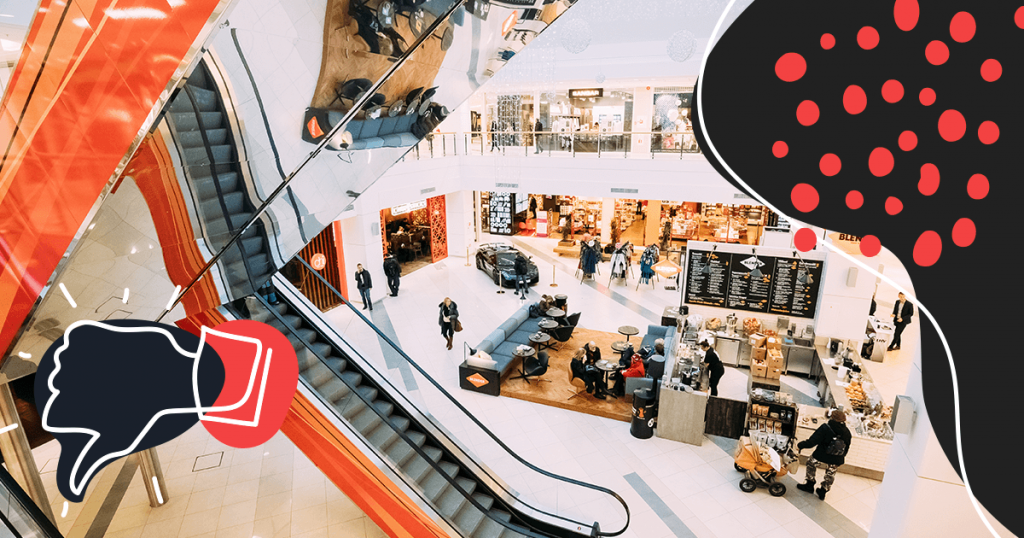The holiday season is a time for family, food, celebrations… and sales.
Brands often find their biggest sales months happen at the end of the year, which can add additional stress to marketers trying to create the most effective digital marketing campaigns.
And since Black Friday is the greatest shopping day of the year, smart brands are already planning their approach to get in on the action.
But far too many brands spend their time, effort, and ultimately their money on the wrong things.
This is a list of the 16 biggest Black Friday mistakes businesses often make to help you avoid errors and plan accordingly to make the most of the season.
- 1. Focusing Only on Discounts
- 2. Targeting the Wrong Customers
- 3. Not Diversifying Audiences
- 4. Not Planning Ahead
- 5. Letting Abandoned Carts Sit
- 6. Leaving Audiences to Fend for Themselves
- 7. Only Creating “Holiday” Offers
- 8. Underestimating Online Sales
- 9. Thinking You Don’t Need a Full Campaign
- 10. Not Collecting Customer Data
- 11. Waiting Too Late to Launch Campaigns
- 12. Thinking Urgency Will Create Itself
- 13. Assuming Customers Will Come to You
- 14. Forgetting Cyber Monday
- 15. Internal Miscommunications
- 16. Being Unrealistic
- Wrap-Up: Now You are Ready to Avoid these Black Friday Mistakes
1. Focusing Only on Discounts
Many brands and marketers assume that discounts are the only way to go on Black Friday.
After all, markdowns and special low prices are often the number one attraction for customers looking to get a great deal.
However, there are many other types of deals you can offer that can bring even more business in through the door.
Here are a few ideas you can try instead of plain discounts:
BOGO Sales
Buy one get one, or BOGO sales, are a great way to draw in customers who want to get the most for their money.
Your BOGO sale can be a buy one, get one free, or a buy one, get one half off deal, but the main attraction is the perceived savings customers get.
Just make sure your sale is for items people are going to want multiples of.
Free Shipping
Shipping fees can cause customers to abandon their purchases or start to second guess them, even if the fee is only a few dollars.
Offering free shipping on your Black Friday sales will help you bring customers all the way to the finish line for online sales.
Free Gifts with Purchase
Like a BOGO sale, a free gift can entice customers with the idea that they will be receiving more than what they paid for.
A free gift can be a small item like a tote bag or toy or a more expensive gift like a bracelet or jewelry.
But no matter the size, they can help you drive shoppers to make a purchase they might not have made otherwise to avoid missing out on a gift.
2. Targeting the Wrong Customers
A huge aspect of a successful Black Friday campaign is understanding who your customers are and marketing towards specific groups.
While you might have a target audience for your products or services, during Black Friday your current customers are going to be people purchasing gifts for your ideal buyers.
You’ll need to adjust your ad and targeting strategies to reach the right people and make sure you don’t let interested parties go unnoticed, as well as broaden your audience qualifications during ad campaigns so that your messaging is seen by a wider audience.
3. Not Diversifying Audiences
While you want to work on retargeting your ads to actual buyers, not just your ideal buyers, during Black Friday, you also need to take the time to refine those ideal buyers and use data to update your buyer profiles.
You can use geo-locating technology and exit data from any brick-and-mortar location to get a better snapshot of your customers to know who to include.
4. Not Planning Ahead
One of the biggest Black Friday mistakes brands make is not planning ahead with enough time.
A successful Black Friday marketing strategy can’t just be thrown together at the last minute.
You need to spend time researching and developing a strategy that will bring in the most results for you and your business.
When you plan well ahead, you can take the time to see how early parts of your campaigns are performing or adjust your messaging and designs to try and capture more consumers.
Your marketing needs to start well ahead of the actual event, but without a strategy, in time your brand will lose out on sales and revenue.
5. Letting Abandoned Carts Sit
Cart abandonment is one of the top reasons that sales don’t reach their full potential during Black Friday.
Whether shoppers are having second thoughts, searching for other deals to compare, or have simply forgotten their cart, ignoring those dollars is a big mistake.
You can use customer data to send reminders in the form of emails or even text messages to customers with abandoned carts and ask them to come back and complete the purchase.
This can help remind consumers of their purchases or, at the very least, empty their cart so you have a better understanding of potential sales.
6. Leaving Audiences to Fend for Themselves
Another reason customers might leave without making purchases is feeling overwhelmed.
Leaving a customer to fend for themselves without any assistance can lead them to feel stressed or ignored, and they will move on to other brands.
Work on improving your user experiences on your website and updating chatbots or live chat features to help customers connect with answers or staff who can guide them to what they are looking for.
7. Only Creating “Holiday” Offers
While most marketers and brands know to keep their end-of-the-year offers somewhat open with general terms like “holiday” rather than specific days, there can still be a disconnect if that’s all you focus on.
Your Black Friday and end-of-the-year messaging should be broad enough to include offers outside of holiday deals for customers looking for products and services for other reasons.
8. Underestimating Online Sales
Marketers, even digital marketers, can sometimes make the mistake of thinking that online sales won’t match the in-store sales of Black Friday.
The truth is that online sales can sometimes overtake your in-store sales.
If you don’t put time and energy into creating a great online experience, you might find that customers turn away from your brand entirely.
In order to bring in the most online sales, you’ll also need to focus on our eCommerce store and make sure that your navigation is clear, your forms are easy to fill in, and your products have great images and descriptions to drive sales.
9. Thinking You Don’t Need a Full Campaign
Some marketers think that a single Black Friday ad or resource will be enough to bring in customers.
In reality, you need to develop a full campaign from start to finish to ensure you get the most out of the Black Friday shopping season.
Without a fully-developed plan, you could miss out on key touchpoint events that raise awareness and draw in customers.
10. Not Collecting Customer Data
As Black Friday is the biggest shopping day of the year, you have incredible opportunities to collect customer data and increase your customer database.
If you don’t take customers’ emails and information, you could be missing out on the chance to drastically increase your future sales.
When you collect your customer data, not only do you grow your database for marketing and retargeting in the future, but you can also expand your understanding of buyer profiles and ideal customers.
The data you collect can also help you determine which channels are the most successful and further develop digital marketing strategies in the future.
11. Waiting Too Late to Launch Campaigns
Even if you have a beautiful, well-researched, and well-rounded campaign, it can all be for nothing if you wait too long for it to launch.
Awareness-level emails and earlier sale dates like a Black Friday Preview Sale can help to market your Black Friday deals well before the actual date.
Waiting too late can mean that customers have already mentally allocated their budget to other brands, or have found similar deals to yours in other companies and have made an internal commitment to your competitors.
12. Thinking Urgency Will Create Itself
One of the reasons Black Friday is such a successful day for shopping and sales year and year again is the urgency of the date.
The fear of missing incredible deals during this one-a-year sales event creates a real psychological trigger in shoppers to purchase fast.
If your marketing strategy doesn’t play into the resource scarcity and urgency created, you can lose out on impulse buys.
Try tricks like a countdown clock, deal expiration times, “today only” messaging, or product stock limits to help push your audiences to buy.
13. Assuming Customers Will Come to You
Just like marketers will often think urgency will create itself, they also will think that customers will automatically come to them on Black Friday.
After all, won’t loyal customers of your brand search for the Black Friday deals you’re offering?
Even loyal brand advocates can be overwhelmed by the number of ads and deals available during Black Friday, and without getting your message and deal information in front of them, you can be lost in the mix.
Never assume that your customers are going to come to you — it’s your job to create ads, campaigns, and touchpoints that will guide customers to your store.
14. Forgetting Cyber Monday
With the term “Black Friday” thrown around all the time during the end of the year, some brands completely forget about Cyber Monday.
Cyber Monday is a relatively new shopping day that falls on the immediate Monday after Black Friday.
Cyber Monday is a day known for online shopping, so many traditional brick-and-mortar brands forget to include it.
However, you don’t want to hurt your Black Friday shoppers by offering better deals on Cyber Monday.
One tip is to pick different products to focus on for each event so you can spread out shopping and avoid offending customers by offering a better deal on a different day.
Another good tip is to think of Black Friday and Cyber Monday as two pushes in a single event.
Your Black Friday and Cyber Monday sales should work together to offer deals to customers on both days and use different messaging to capture the nuances in tone of each shopping day.
15. Internal Miscommunications
A strong Black Friday strategy doesn’t just look at your communication with customers, but at your internal communication as well.
The end of the year can be the most stressful for your team.
Not only are they putting together Black Friday deals, but they are also customers of other brands at the same time.
In addition to the stress from work, employees also want to enjoy time off with family or to take vacations around holidays.
Having a clear plan and internal strategy as well as being open with team members can take some of the stress out of Black Friday planning in the office and help your organization flow smoothly in preparation for the big day.
16. Being Unrealistic
With so much potential invested in Black Friday, it’s not hard to see why some brands and marketers take on more than they can handle.
Some brands try to do too much and end up stretched too thin and don’t have the time or workforce to manage all aspects of the event.
You also need to be realistic about things like:
- Your shipping times.
- What you currently have in inventory.
- And how long it takes to restock products.
If you promise more than you can deliver, you’ll seriously damage your brand reputation as well as hurt customers who depend on your word.
Wrap-Up: Now You are Ready to Avoid these Black Friday Mistakes
Black Friday is the kick-off to the holiday season and the single biggest shopping day of the year.
Without a plan, however, marketers can end up making big Black Friday mistakes that affect their bottom line in a negative way.
If you’re a marketer who is looking to get more out of their digital ads, then check out our ad performance resource and learn what you can do to help improve your digital ads any time of the year.











